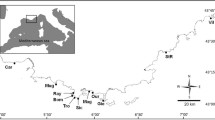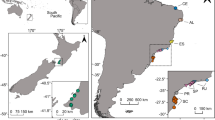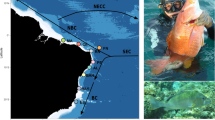Abstract
Ecological opportunities, such as access to a novel habitat or the extirpation of a key competitor, can lead to adaptive divergence by exposing populations to diversifying selection. Typically, effects of ecological opportunity on adaptive divergence are inferred from macroevolutionary patterns rather than tested in populations undergoing contemporary divergence. This limits our insight on how ecological conditions contribute to adaptive divergence. Pumpkinseed sunfish (Centrarchidae: Lepomis gibbosus) have recently and repeatedly colonized a ‘novel’ pelagic habitat in postglacial lakes, and subsequently undergone phenotypic diversification. We investigated whether ecological opportunity has contributed to diversification in a pumpkinseed population that has diversified between lake habitats. We used a between-year mark-recapture study to evaluate whether (1) the novel pelagic habitat represents an ecological opportunity by supporting a large, high-density population, and (2) connectivity between ecotype populations is restricted by limited adult dispersal. We found that phenotypic variation is spatially structured between habitats, similar to prior studies. Submerged shoals in the pelagic habitat do sustain a large adult population at a density seven times greater than the ancestral littoral habitat. Additionally, body condition and size of pelagic pumpkinseed is similar to littoral pumpkinseed. This suggests the pelagic habitat provides an ecological opportunity to pumpkinseed in the form of abundant, available resources. Furthermore, strong between-year habitat fidelity suggests aspects of the ecological opportunity have reduced adult dispersal and could limit gene flow. In combination with prior evidence indicating diversifying selection between habitats, these results provide an example of how ecological opportunity might contribute to contemporary adaptive divergence.





Similar content being viewed by others
Data accessibility
The data for this study has been included in online supplementary material. We intend to archive our data with Dryad Digital Repositories https://datadryad.org/
References
Allison LN, Hnath JG, Yoder WG (1977) Manual of common diseases, parasites and anomalies of Michigan fishes. Fisheries Management Report No. 8. Lansing, Michigan
Axelrod CJ, Laberge F, Robinson BW (2018) Intraspecific brain size variation between coexisting sunfish ecotypes. Proc R Soc B Biol Sci 285:1–8. https://doi.org/10.1098/rspb.2018.1971
Baythavong BS (2011) Linking the spatial scale of environmental variation and the evolution of phenotypic plasticity: selection favors adaptive plasticity in fine-grained environments. Am Nat 178(1):75–87. https://doi.org/10.1086/660281
Berchtold AE, Colborne SF, Longstaffe FJ, Neff BD (2015) Ecomorphological patterns linking morphology and diet across three populations of pumpkinseed sunfish (Lepomis gibbosus). Nat Res Council Res Press 297(February):289–297
Berlocher SH, Feder JL (2002) Sympatric speciation in phytophagous insects: Moving beyond controversy? Annu Rev Entomol 47:773–815
Bolnick DI, Fitzpatrick BM (2007) Sympatric speciation: models and empirical evidence. Annu Rev Ecol Evol Syst 38(1):459–487. https://doi.org/10.1017/S1743921310002723
Bowler DE, Benton TG (2004) Causes and consequences of animal dispersal strategies: relating individual behaviour to spatial dynamics. Biol Rev 80:205–225. https://doi.org/10.1017/S1464793104006645
Brennan NP, Leber KM, Blankenship HL, Ransier JM, DeBruler R (2005) An evaluation of coded wire and elastomer tag performance in juvenile common snook under field and laboratory conditions. N Am J Fish Manag 25(2):437–445. https://doi.org/10.1577/M04-003.1
Clopper CJ, Pearson ES (1934) The use of confidence or fiducial limits illustrated in the case of the binomial. Biometrika 26(4):404–413
Colborne SF, Garner SR, Longstaffe FJ, Neff BD (2016) Assortative mating but no evidence of genetic divergence in a species characterized by a trophic polymorphism. J Evol Biol 29(3):633–644. https://doi.org/10.1111/jeb.12812
Danylchuk AJ, Fox MG (1994) Age and size-dependent variation in the seasonal timing and probability of reproduction among mature female pumpkinseed, Lepomis gibbosus. Environ Biol Fishes 39(2):119–127. https://doi.org/10.1007/BF00004929
Dettmers JM, Janssen J, Pientka B, Fulford RS, Jude DJ (2005) Evidence across multiple scales for offshore transport of yellow perch (Perca flavescens) larvae in Lake Michigan. Can J Fish Aquat Sci 62(12):2683–2693. https://doi.org/10.1139/f05-173
Doenz CJ, Bittner D, Vonlanthen P, Wagner CE, Seehausen O (2018) Rapid buildup of sympatric species diversity in Alpine whitefish. Ecol Evol 8(18):9398–9412. https://doi.org/10.1002/ece3.4375
Dres M, Mallet J (2002) Host races in plant-feeding insects and their importance in sympatric speciation. Philos Trans R Soc B Biol Sci 357(1420):471–492. https://doi.org/10.1098/rstb.2002.1059
Edelaar P, Bolnick DI (2012) Non-random gene flow: an underappreciated force in evolution and ecology. Trends Ecol Evol 27(12):659–665. https://doi.org/10.1016/j.tree.2012.07.009
Edelaar P, Siepielski AM, Clobert J (2008) Matching habitat choice causes directed gene flow: a neglected dimension in evolution and ecology. Evolution 62(10):2462–2472. https://doi.org/10.1111/j.1558-5646.2008.00459.x
Fish PA, Savitz J (1983) Variations in home ranges of largemouth bass, yellow perch, bluegills, and pumpkinseeds in an Illinois Lake. Trans Am Fish Soc 112(2A):147–153. https://doi.org/10.1577/1548-8659(1983)112%3c147:VIHROL%3e2.0.CO;2
Fox MG (1994) Growth, density, and interspecific influences on pumpkinseed sunfish life histories. Ecology 75(4):1157–1171
Fruciano C, Franchini P, Kovacova V, Elmer KR, Henning F, Meyer A (2016) Genetic linkage of distinct adaptive traits in sympatrically speciating crater lake cichlid fish. Nat Commun 7:1–8. https://doi.org/10.1038/ncomms12736
Gillespie GJ, Fox MG (2003) Morphological and life-history differentiation between littoral and pelagic forms of pumpkinseed. J Fish Biol 62(5):1099–1115. https://doi.org/10.1046/j.1095-8649.2003.00100.x
Gislason D, Ferguson M, Skulason S, Snorrason SS (1999) Rapid and coupled phenotypic and genetic divergence in Icelandic Arctic char (Salvelinus alpinus). Can J Fish Aquat Sci 56(12):2229–2234. https://doi.org/10.1139/cjfas-56-12-2229
Givnish TJ, Millam KC, Mast AR, Paterson TB, Theim TJ, Hipp AL et al (2009) Origin, adaptive radiation and diversification of the Hawaiian lobeliads (Asterales: Campanulaceae). Proc R Soc B Biol Sci 276(1656):407–416. https://doi.org/10.1098/rspb.2008.1204
Grimm A, Gruber B, Henle K (2014) Reliability of different mark-recapture methods for population size estimation tested against reference population sizes constructed from field data. PLoS ONE. https://doi.org/10.1371/journal.pone.0098840
Hendry AP, Taylor EB (2004) How much of the variation in adaptive divergence can be explained by gene flow? An evaluation using lake-stream stickleback Pairs. Evolution 58(10):2319–2331. https://doi.org/10.1111/j.0014-3820.2004.tb01606.x
Henning F, Machado-Schiaffino G, Baumgarten L, Meyer A (2017) Genetic dissection of adaptive form and function in rapidly speciating cichlid fishes. Evolution 71(5):1297–1312. https://doi.org/10.1111/evo.13206
Houde ED (1994) Differences between marine and freshwater fish larvae: implications for recruitment. ICES J Mar Sci 51:91–97. https://doi.org/10.1006/jmsc.1994.1008
Jarvis WMC, Comeau SM, Colborne SF, Robinson BW (2017) Flexible mate choice may contribute to ecotype assortative mating in pumpkinseed sunfish (Lepomis gibbosus). J Evol Biol 30(10):1810–1820. https://doi.org/10.1111/jeb.13127
Jastrebski CJ, Robinson BW (2004) Natural selection and the evolution of replicated trophic polymorphisms in pumpkinseed sunfish (Lepomis gibbosus). Evol Ecol Res 6:285–305
Kirkpatrick M (2000) Reinforcement and divergence under assortative mating. Proceedings of the Royal Society B: Biological Sciences 267(1453):1649–1655. https://doi.org/10.1098/rspb.2000.1191
Lenormand T (2002) Gene flow and the limits to natural selection. Trends Ecol Evol 17(4):183–189. https://doi.org/10.1016/S0169-5347(02)02497-7
Lovette IJ, Bermingham E, Ricldefs RE (2002) Clade-specific morphological diversification and adaptive radiation in Hawaiian songbirds. Proc R Soc B Biol Sci 269(1486):37–42. https://doi.org/10.1098/rspb.2001.1789
Lu G, Bernatchez L (1999) Correlated trophic specialization and genetic divergence in sympatric lake whitefish ecotypes (Coregonus clupeaformis): support for the ecological speciation hypothesis. Evolution 53(5):1491–1505
Mallet J (2001) Gene Flow. Heredity 72(1):337–360
Martin CH, Wainwright PC (2013) Multiple fitness peaks on the adaptive landscape drive adaptive radiation in the wild. Science 339(6116):208–211. https://doi.org/10.1126/science.1227710
Matsumura S, Arlinghaus R, Dieckmann U (2010) Foraging on spatially distributed resources with sub-optimal movement, imperfect information, and travelling costs: departures from the ideal free distribution. Oikos 119:1469–1483
McCairns RJS, Fox MG (2004) Habitat and home RANGE fidelity in a trophically dimorphic pumpkinseed sunfish (Lepomis gibbosus) population. Oecologia 140(2):271–279. https://doi.org/10.1007/s00442-004-1580-9
McKinnon JS, rundle HD (2002) speciation in nature: the threespine stickleback model systems. Trends Ecol Evol 17(10):480–488. https://doi.org/10.1016/S0169-5347(02)02579-X
Murphy SC, Collins NC, Doka SE (2012) The effects of cool and variable temperatures on the hatch date, growth and overwinter mortality of a warmwater fish in small coastal embayments of Lake Ontario. J Great Lakes Res 38(3):404–412. https://doi.org/10.1016/j.jglr.2012.06.004
Nosil P, Crespi BJ (2004) Does gene flow constrain adaptive divergence or vice versa? A test using ecomorphology and sexual isolation in Timema cristinae walking-sticks. Evolution 58(1):102–112. https://doi.org/10.1111/j.0014-3820.2004.tb01577.x
Nosil P, Crespi BJ, Sandoval CP (2003) Reproductive isolation driven by the combined effects of ecological adaptation and reinforcement. Proc R Soc B Biol Sci 270(1527):1911–1918. https://doi.org/10.1098/rspb.2003.2457
Nosil P, Sandoval CP, Crespi BJ (2006) The evolution of host preference in allopatric vs. parapatric populations of Timema cristinae walking-sticks. J Evol Biol 19(3):929–942. https://doi.org/10.1111/j.1420-9101.2005.01035.x
O’Hara RB, Kotze DJ (2010) Do not log-transform count data. Methods Ecol Evol 1(2):118–122. https://doi.org/10.1111/j.2041-210X.2010.00021.x
Osenberg CW, Werner EE, Mittelbach GG, Hall DJ (1988) Growth patterns in bluegill (Lepomis macrochirus) and pumpkinseed (L. gibbosus) sunfish: environmental variation and the importance of ontogenetic niche shifts. Can J Fish Aquat Sci 45:17–26
Osenberg CW, Mittelbach GG, Wainwright PC (1992) Two-stage life histories in fish: the interaction between juvenile competition and adult performance. Ecology 73(1):255–267. https://doi.org/10.2307/1938737
Parsons KJ, Robinson BW (2006) Replicated evolution of integrated plastic responses during early adaptive divergence. Evolution 60(4):801–813. https://doi.org/10.1111/j.0014-3820.2006.tb01158.x
Parsons KJ, Robinson BW (2007) Foraging performance of diet-induced morphotypes in pumpkinseed sunfish (Lepomis gibbosus) favours resource polymorphism. J Evol Biol 20(2):673–684. https://doi.org/10.1111/j.1420-9101.2006.01249.x
Peig J, Green AJ (2010) The paradigm of body condition: a critical reappraisal of current methods based on mass and length. Funct Ecol 24(6):1323–1332. https://doi.org/10.1111/j.1365-2435.2010.01751.x
R Development Core Team (2018) R: A language and environment for statistical computing. Retrieved from http://www.r-project.org
Ravigne V, Dieckmann U, Olivieri I (2009) Live where you thrive: joint evolution of habitat choice and local adaptation facilitates specialization and promotes diversity. Am Nat 174(4):E141–E169. https://doi.org/10.1086/605369
Ravinet M, Yoshida K, Shigenobu S, Toyoda A, Fujiyama A, Kitano J (2018) The genomic landscape at a late stage of stickleback speciation: High genomic divergence interspersed by small localized regions of introgression. PLoS Genet 14(5):1–32. https://doi.org/10.1371/journal.pgen.1007358
Robinson BW, Schluter D (2000) Natural selection and the evolution of adaptive genetic variation in northern freshwater fish. In: Mousseau TA, Sinervo B, Endler JA (eds) Adaptive genetic variation in the wild. Oxford University Press, Oxford, pp 65–94
Robinson BW, Wilson DS (1994) Character Release and Displacement in Fishes: A Neglected Literature. Am Nat 144(4):596–627
Robinson BW, Wilson DS (1996) Genetic variation and phenotypic plasticity in a trophically polymorphic population of pumpkinseed sunfish (Lepomis gibbosus). Evol Ecol 10(6):631–652. https://doi.org/10.1007/BF01237711
Robinson BW, Wilson DS, Margosian AS, Lotito P (1993) Ecological and morphological differentiation of pumpkinseed sunfish in lakes without bluegill sunfish. Evol Ecol 7:451–464
Robinson BW, Wilson DS, Shea GO (1996) Trade-offs of ecological specialization: an intraspecific comparison of pumpkinseed sunfish phenotypes. Ecology 77(1):170–178
Robinson BW, Wilson DS, Margosian AS (2000) A pluralistic analysis of character release in pumpkinseed sunfish (Lepomis Gibbosus). Ecology 81(10):2799–2812
Roderick GK, Gillespie RG (1998) Speciation and phylogeography of Hawaiian terrestrial arthropods. Mol Ecol 7(4):519–531. https://doi.org/10.1046/j.1365-294x.1998.00309.x
Scheiner SM (2016) Habitat choice and temporal variation alter the balance between adaptation by genetic differentiation, a jack-of-all-trades strategy, and phenotypic plasticity. Am Nat. https://doi.org/10.1086/685812
Schluter D (1993) Adaptive radiation in sticklebacks: size, shape, and habitat use efficiency. Ecology 74(3):699–709. https://doi.org/10.2307/1940797
Schluter D (2000) The ecology of adaptive radiation. Oxford University Press, Oxford
Schluter D (2009) Evidence for ecological speciation and its alternative. Science 323:737–741
Schluter D, Grant PR (1984) Determinants of morphological patterns in communities of Darwin’s finches. Am Nat 123(2):175–196. https://doi.org/10.1086/284196
Schluter D, Mcphail JD (1992) Ecological character displacement and speciation in sticklebacks. Am Nat 140(1):85–108
Scott WB, Crossman EJ (1973) Freshwater fishes of Canada. In: H Caspers (Ed). https://doi.org/10.2307/1442619
Seber GAF (1982) The estimation of animal abundance and related parameters, 2nd edn. Macmillon Publication Co., NewYork
Seehausen O, Wagner CE (2014) Speciation in freshwater fishes. Annu Rev Ecol Evol Syst 45(1):621–651. https://doi.org/10.1146/annurev-ecolsys-120213-091818
Simpson GG (1953) The major features of evolution. Columbia University Press, New York
Stroud JT, Losos JB (2016) Ecological opportunity and adaptive radiation. Annu Rev Ecol Evol Syst 47:507–532. https://doi.org/10.1146/annurev-ecolsys-121415-032254
Sturmbauer C (1998) Explosive speciation in cichlid of the African Great Lakes: a dynamic model of adaptive radiation. J Fish Biol 53:18–36. https://doi.org/10.1111/j.1095-8649.1998.tb01015.x
Suski CD, Ridgway MS (2009) Winter biology of centrarchid fishes. In: Cooke SJ, Philipp DP (eds) Centrarchid fishes: diversity, biology, and conservation. Wiley-Blackwell, New York, pp 264–292
Wainwright PC (1991) Ecomorphology: exprimental functional anatomy for ecological problems. American Zoologist 31(December 1989):680–693
Weese DJ, Ferguson MM, Robinson BW (2012) Contemporary and historical evolutionary processes interact to shape patterns of within-lake phenotypic divergences in polyphenic pumpkinseed sunfish. Lepomis gibbosus. Ecol Evol 2(3):574–592. https://doi.org/10.1002/ece3.72
Wellborn GA, Langerhans RB (2015) Ecological opportunity and the adaptive diversification of lineages. Ecol Evol 5(1):176–195. https://doi.org/10.1002/ece3.1347
Werner EE, Hall DJ (1977) Competition and habitat shift in two sunfishes (Centrarchidae). Ecology 58:869–876
Wilson ADM, Godin JGJ (2009) Boldness and behavioral syndromes in the bluegill sunfish, Lepomis macrochirus. Behav Ecol 20(2):231–237. https://doi.org/10.1093/beheco/arp018
Wilson DS, Muzzall PM, Ehlinger TJ (1996) Parasites, morphology, and habitat use in a Bluegill Sunfish (Lepomis macrochirus) population. Copiea 2:348–354
Yoder JB, Clancey E, Des Roches S, Eastman JM, Gentry L, Godsoe W et al (2010) Ecological opportunity and the origin of adaptive radiations. J Evol Biol 23:1581–1596. https://doi.org/10.1111/j.1420-9101.2010.02029.x
Acknowledgements
We would like to thank C. Nolan and C. Axelrod for assistance with field work, as well as C. Axelrod, K. Cantera, K. Cottenie, R. Holub, K. McCann, R. McLaughlin, H. Rundle, and 3 anonymous reviewers for feedback on earlier versions of this manuscript. We acknowledge the funding that made this work possible: A Natural Sciences and Engineering Research Council of Canada (Grant No. RGPIN-2014-04455) Discovery grant to B. Robinson and The Norman James Aquatic Animal Ecology Award from the College of Biological Sciences at the University of Guelph to W. Jarvis. We thank Bob and Christine Gautier and the Ashby Lake Protective Association for facilitating our work on Ashby Lake. Methods of capture, handling, anesthetic, and euthanasia of animals were in accordance with animal use and welfare standards administered by the University of Guelph’s Animal Care Committee (AUP#3773) under Canadian government guidelines (UAREB No. 1500). Sampling was licensed through the collection of fish for scientific purposes administered by the Ontario Ministry of Natural Resources (#1082601 and #1086710).
Author information
Authors and Affiliations
Contributions
WJ, KP, SC, and BR conceived the ideas and designed methodology; WJ, KP, and BR collected the data; WJ and BR analyzed the data; WJ and BR led the writing of the manuscript. All authors contributed critically to the drafts and gave final approval for publication.
Corresponding author
Ethics declarations
Conflict of interest
The authors declare no conflicts of interest
Additional information
Publisher's Note
Springer Nature remains neutral with regard to jurisdictional claims in published maps and institutional affiliations.
Electronic supplementary material
Below is the link to the electronic supplementary material.
Rights and permissions
About this article
Cite this article
Jarvis, W.M.C., Peiman, K.S., Cooke, S.J. et al. Low connectivity between sympatric populations of sunfish ecotypes suggests ecological opportunity contributes to diversification. Evol Ecol 34, 391–410 (2020). https://doi.org/10.1007/s10682-020-10042-4
Received:
Accepted:
Published:
Issue Date:
DOI: https://doi.org/10.1007/s10682-020-10042-4




